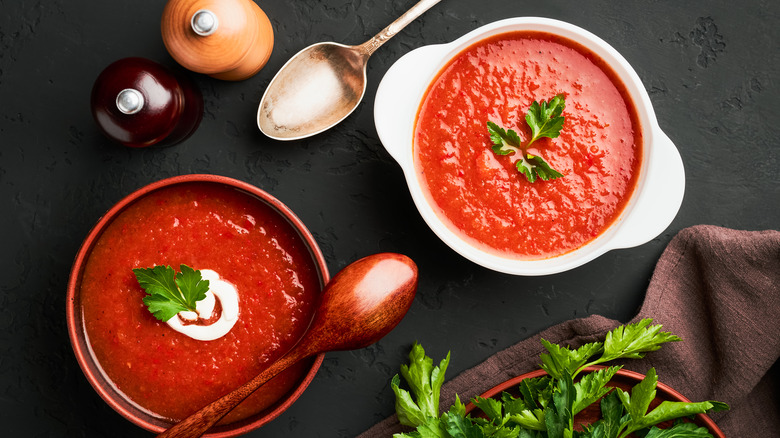Tomato Soup Vs. Tomato Bisque: Is There A Difference?
With the winter cold in full swing, there is nothing as comforting as snuggling up on the couch with a warm meal. While there are plenty of comfort foods, it's hard to beat a hot bowl of winter soup to keep the cold away. Tomato soup and bisque are among the many options you could choose. Not only are they delicious, but they will also allow you to keep up with your nutritional needs (via Healthline). For a regular home cook, you'd be forgiven for thinking that soup and bisque are the same.
While they share an almost similar consistency, soups and bisques are totally different, and the same is true for tomato soup and tomato bisque. While soup is a general term used to describe all liquid dishes, including bisque, there is no doubt that there is a lot of grey area when talking about the differences. In that regard, this post attempts to shed some light on this topic and finally bring the long-contested battle to rest.
What is soup?
To fully comprehend this hot topic, it is necessary to understand the building blocks of what makes up a soup. It is one of the few meals you don't need an explanation for because you know when you see it. So what exactly is soup? As mentioned earlier, soup is a general term for liquid meals. You can prepare countless varieties with no limitation to the ingredients or the consistency, and the possibilities are as limited as your creativity in the kitchen.
According to Delighted Cooking, any liquid food with tomato as the base ingredient can easily be referred to as tomato soup. The benefits of a home-cooked tomato soup extend beyond giving you comfort during cold winter nights. Tomatoes are packed with many vitamins and other antioxidizing properties that have proven beneficial in reducing obesity and also help in protecting against cardiovascular diseases and cancer, according to research in Critical Reviews of Food Science and Nutrition.
What is bisque?
The simplest explanation is that bisque is a particular type of soup that is often thick and incredibly creamy, according to an article by Linn–Benton Community College. When it comes to popular soups made from seafood, bisques have to be at the top of the list. Originally, bisque was made from shellfish and became thick by crushing the shells and making them into a paste to thicken them further. However, it is also worth mentioning that modern-day bisques have taken different forms and are even more flavorful. Unlike their traditional counterparts, bisques today can be made from vegetables like butternut squash or even tomatoes.
Because of the evolution of this delicacy, the name bisque refers to the creamy texture rather than the actual ingredients of the soup. Just like any other version, tomato bisque is one of the modern ways to prepare a creamy soup where the primary ingredient is tomato. Cream is an essential ingredient for making tomato bisque, as it's responsible for achieving that elusive texture signature to this dish, according to The Cookful. The beauty of tomato bisque is that the thickness is filling, and the smooth texture makes it relatively easy to consume.
What is the difference between tomato soup and bisque?
Although tomato bisque is technically a soup, several clear-cut differences separate the two. One of the most apparent distinctions lies in the ingredients. According to The Crowded Table, the critical components for making tomato soup are tomatoes and either chicken or vegetable stock. On the other hand, making tomato bisque involves using heavy cream along with the aforementioned ingredients. You can easily spot the difference between the two when they are served side-by-side based on their consistency.
While some tomato soups also use cream, like a creamy tomato-basil soup, the difference only comes during the preparation phase. When preparing a bisque, the cream is used during the early stages of cooking, according to The Kitchen Community. This is particularly important to maintain a relatively thicker consistency while also taking advantage of the texture of the cream. The evolution of bisque has made it easier to create your own at home without using seafood. Whichever route you choose, your tomato soup (or bisque) is sure to be a hit.



